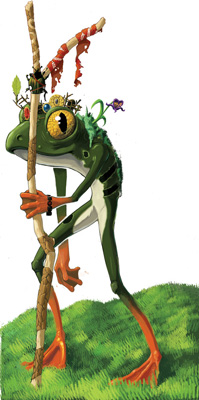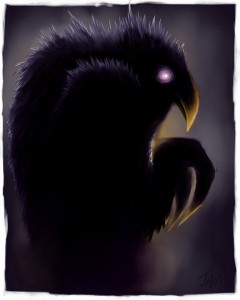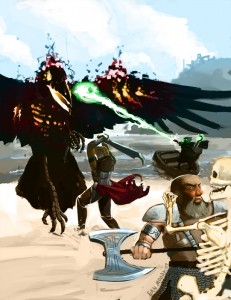 On May 22, I released a free 61 page 4th edition Dungeons and Dragons campaign setting entitled the New World as a PDF. It’s over 22,000 words; features original art from four talented artists and did not cost me a dime to produce. I also made over $520 from creating it but I wasn’t paid by a RPG publisher. Instead, fans of the New World donated the entire sum using fundable.com so I could get paid for my work and release the PDF for free. This is the ransom model, pioneered by Greg Stolze.
On May 22, I released a free 61 page 4th edition Dungeons and Dragons campaign setting entitled the New World as a PDF. It’s over 22,000 words; features original art from four talented artists and did not cost me a dime to produce. I also made over $520 from creating it but I wasn’t paid by a RPG publisher. Instead, fans of the New World donated the entire sum using fundable.com so I could get paid for my work and release the PDF for free. This is the ransom model, pioneered by Greg Stolze.
Other tabletop game designers have used the model to finance their work, but they were typically well known in the community and the products they put out through a ransom had a good reputation. For example, Dennis Detwiller co-created Delta Green, an award winning Call of Cthulhu campaign setting. So when he set up ransoms to pay for several Delta Green scenarios, fans had a good idea of what they would get. However, the New World has no publication history. It only began as an informal set of notes for my weekly D&D game. The only reason anyone was willing to pay into the New World ransom or even knew about the campaign was through my podcast.
I am the co-host of Role Playing Public Radio, a tabletop RPG podcast. Aside from a biweekly talk show discussing these games in general, we also record actual play episodes. The actual play shows are normal tabletop RPG games recorded with a digital audio recorder. I use a Zoom H2 recorder, which can record 360 degrees, catching everyone’s voice at the table equally, more or less. These games run from 2 to 5 hours on average. I do not edit them for content, only for quality before I encode them to MP3 and post them on the podcast. They have proven to be popular and I make it a point to record every game I play or run in.
The idea for the New World came to me when I saw a documentary about Columbus’ later voyages and governorship. The 4th edition of Dungeons and Dragons came out last year and several listeners had asked me to record a 4E game as an actual play. A D&D game based on the challenges presented with colonization and exploration seemed much more interesting than the average ‘save the world from evil’ narrative. Moral dilemmas over limited resources and the exploitation of the natives also had its own appeal. I wanted the players to initiate the action instead of passively waiting for a NPC to hand out quests to them. So I wrote some notes down and began the campaign.
 When I posted the first game, it was a hit, judging from the reactions of the listeners. I continued to run the game and develop the setting. By the seventh game, I had decided to write up the campaign and use the ransom model as a way to pay for RPPR’s hosting fees and some recording gear. I wrote an outline of the New World Primer and set up a ransom on fundable.com. In order to promote the ransom, I reached out to the network of RPPR fans.
When I posted the first game, it was a hit, judging from the reactions of the listeners. I continued to run the game and develop the setting. By the seventh game, I had decided to write up the campaign and use the ransom model as a way to pay for RPPR’s hosting fees and some recording gear. I wrote an outline of the New World Primer and set up a ransom on fundable.com. In order to promote the ransom, I reached out to the network of RPPR fans.
RPPR has a presence on several social networks, primarily Facebook and Myspace. Fundable limits all donation drives to 26 days, so I sent out reminders about the ransom several times so that fans wouldn’t forget about it. Every episode released during the ransom drive also had a promo about the ransom. Fortunately, the fans responded and the ransom was met so I began work on it.
A great deal of the work was already done, as I had written quite a bit for the campaign. To flesh it out better, I asked several of my friends who I knew were talented writers if they wanted to contribute any writing to it. While I was prepared to write the entire primer myself, I figured it wouldn’t hurt to have even more content. The RPPR co-host, Tom Church wrote adventure hooks to give GMs running the game ideas for their own campaigns. Cody Walker, one of the players in the game, contributed background material while Patrick Seth Williams, a friend of mine from grad school wrote a great essay about historical colonial law. With this in mind, I also sent out a request for art on the main RPPR site and received free work from four talented artists.
 Once I released the primer, I created a static page to showcase the art and make the primer more visible on the main site. Since I plan to create more material for the New World in the future, I’ll update the page with any future PDFs.
Once I released the primer, I created a static page to showcase the art and make the primer more visible on the main site. Since I plan to create more material for the New World in the future, I’ll update the page with any future PDFs.
Given the amount of time spent creating and laying the primer out, I probably could have made more working for someone else as a freelancer. The added value from this project comes from the fact that I retain control over the New World setting. Usually in the tabletop RPG industry, writers sign over copyright and/or control of their work to the publisher. Every contributor to the primer kept copyright on their art or text. But since I wrote the main text, I can develop the setting in the future in any number of ways.
A growing number of artists are earning good revenue through the Internet but many critics point out that most of them had a reputation before they began to earn any money over the web. Through this project, I’ve learned it’s possible to develop a marketable brand solely on the Internet, even in a niche industry like tabletop RPGs.
 On May 22
On May 22 When I posted the first game, it was a hit, judging from the reactions of the listeners. I continued to run the game and develop the setting. By the seventh game, I had decided to write up the campaign and use the ransom model as a way to pay for RPPR’s hosting fees and some recording gear. I wrote an outline of the New World Primer and set up a ransom on fundable.com. In order to promote the ransom, I reached out to the network of RPPR fans.
When I posted the first game, it was a hit, judging from the reactions of the listeners. I continued to run the game and develop the setting. By the seventh game, I had decided to write up the campaign and use the ransom model as a way to pay for RPPR’s hosting fees and some recording gear. I wrote an outline of the New World Primer and set up a ransom on fundable.com. In order to promote the ransom, I reached out to the network of RPPR fans. Once I released the primer,
Once I released the primer,